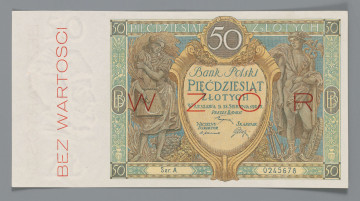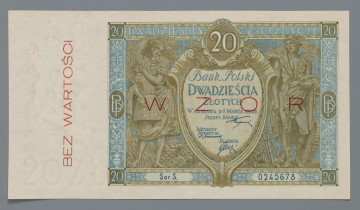
Cheque for 50,000,000 Polish marks - a template
1923
National Museum in Lublin
Part of the collection: Paper money during the Second Polish Republic
The first years after Poland regained independence proved to be extremely difficult. The need to fight for the borders of the newly rebuilt state, combined with the difficult post-war reality, led to significant economic difficulties. One of their manifestations was galloping inflation, which led to the rate of exchange of the US dollar reaching 10,250,000 Polish marks at the beginning of 1924. In this situation, monetary reform became a necessity. Its implementation on 28 April 1924 proved to be a difficult undertaking, spread over many years. In the first phase, the withdrawn Polish marks were replaced by paper money. These were banknotes, the printing of which had already been ordered in 1919. The lowest denominations (1 and 2 zlotys) appeared as pass tickets. Higher denominations – from 5 to 500 zlotys – were put into circulation in their basic role, as banknotes. Despite the introduction of paper money worth almost 700 million zloty, it turned out that it was not enough. Although the quoted amount does not seem large nowadays, one should remember about the difference in purchasing power between the zloty of that time and the zloty of today. For comparison, it is worth noting that during the period in question a teacher's salary was between 100 and 300 zlotys per month. It became necessary to introduce a new issue of banknotes. Attempts were made to salvage the situation by introducing substitute money on the market, but this was a temporary solution and not very beneficial to the Polish economy. In this situation, the simplest solution was to use the existing banknote designs. As the market demanded mainly the lower denominations, it was decided on 15 July 1924 to issue five-, ten- and twenty-zloty banknotes, which at first sight did not differ from the denominations printed in 1919. However, some elements were changed, such as the legal clause, which had an unfortunate wording in the previous issue. Obviously, the signatures of the Bank of Poland employees appearing on the obverse were also changed. The 20-zloty banknotes were printed in a circulation of 11,570,000 pieces. They entered circulation on 30 September 1924 and remained in circulation until 29 February 1928.
Leszek Poniewozik
Author / creator
Dimensions
cały obiekt: height: 158 mm, width: 96 mm
Object type
paper money
Technique
Material
paper
Creation time / dating
Creation / finding place
Owner
The National Museum in Lublin
Identification number
Location / status

1923
National Museum in Lublin

1925
National Museum in Lublin

1926
National Museum in Lublin
DISCOVER this TOPIC
Museum of King Jan III's Palace at Wilanów
DISCOVER this PATH
Educational path